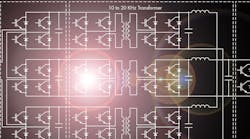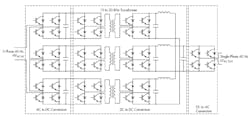Several companies are working on technologies that could replace large traditional power transformers with power semiconductors and smaller transformers mounted on circuit boards. Although they are called solid-state transformers, they are really power converters.
The figure below is a conceptual circuit for a “solid-state transformer” that accepts a three-phase 60 Hz high-voltage input and provides a 60 Hz lower-voltage output. The transistors could be SiC or GaN types with the appropriate specifications. The input circuit converts 60 Hz high voltage ac input to a dc voltage. Then, the dc produces an ac voltage of 10 to 20 kHz that is applied to a step-down transformer. The transformer output is converted to dc and applied to an inverter to produce a lower voltage 60 Hz ac output. The transformer is necessary to provide isolation between the input and output. An advantage of this approach is reduction in size and weight of the transformer because it can operate at a much higher frequency than a 60Hz power transformer.
There may be more to this than meets the eye. Michael Kanellos in his March 2011 article Next for the Grid: Solid State Transformer, published by Greentech Media, wrote, “This process could begin to pave the way for a number of improvements in the way that power gets delivered. Integrating and managing renewable power and electrical storage could become easier. Microgrids could be deployed much more rapidly. Grid efficiency could conceivably be increased by up to 8% to 10% because of lower conversion and transmission losses.”
In describing the advantage of this approach, “that’s 10% less power that you have to generate,” says John Palmour, co-founder and chief technology officer for Power and RF at Cree, a producer of SiCs. “We can replace an 8,000-pound transformer in a substation running at 60 Hz and replace it with one running at 20 kHz in a tiny design. We can shrink it down to [the size of] a suitcase.”
Conceptual circuit for a “solid-state transformer” with a 60 Hz three-phase high-voltage input and a 60 Hz single-phase lower-voltage output.
NC State Report Says Solid-State Transformers Are Ready
Now, fast foward to July 2017. A North Carolina State (NC State) study using complex computational models found that smart solid-state transformers (SSTs) could be used to let power distribution systems route renewable energy from homes and businesses into the grid. Such a grid would improve efficient use of renewable energy and storage but, to date, this version of the smart grid has been mostly conceptual, the report added.
The study indicated the approach could move from concept to reality in the near future using technology that already exists and cited SSTs as the key technology. Solid-state transformers developed at NC State can make this smart grid concept a reality, the study said.
Researchers at the National Science Foundation's FREEDM Systems Center at NC State in 2010 unveiled the first such SST, which not only performed all of the functions of a traditional transformer but could also redirect power as needed to address changes in supply and demand.
“The SST is a fundamental building block in the smart-grid concept,” says Iqbal Husain, ABB distinguished professor of electrical and computer engineering at NC State and director of the FREEDM Center. “It can scale down voltage for use in homes and businesses, but it can also scale up voltage from solar panels or other residential-scale renewable sources in order to feed that power back into the grid.
“And because the SST is a smart technology, it can switch back and forth between those two functions as needed,” he adds. Husain co-authored a paper on the school’s new modeling work. The idea is for the SSTs to work together throughout the larger power grid to coordinate power distribution efficiently.
“We know how individual SSTs work, but the question since 2010 has been how they might work as part of a microgrid and how those microgrids may work in the context of the larger grid,” says Aranya Chakrabortty, an associate professor of electrical and computer engineering at NC State and co-author of the paper. “This is not something that the power industry can afford to get wrong, and we need to ensure that the concept improves efficiency—and is therefore worthy of investment—without adversely affecting the stability and reliability of the grid.”
To that end, researchers developed a complex model that simulates the behavior of a power distribution system, accounting for the SSTs, renewable energy sources, and energy storage. The model is scalable, and thus can be used to predict the behavior of power distribution systems of any size.
“Using this model, we found that SSTs can greatly enhance the functionalities of tomorrow’s power grid,” Chakrabortty says. “However, certain operational boundaries would need to be maintained.”
Essentially, system designers and operators would need to ensure the system—at every level —is taking into account customer power demand, power generation from renewable sources, and energy storage capacity, in order to avoid providing too much or too little power.
“Addressing that challenge is one of the things that SSTs are designed to address,” Husain says. “Now that we know the grid would work better with SSTs, our next step is to develop the algorithms necessary for SSTs to make the split-second decisions needed to keep a system within its operational bounds—something we're already working on.
“We plan to demonstrate this capability in less than a year, and hopefully within the next six months.”
An NC State paper, titled “Equilibrium Point Analysis and Power Sharing Methods for Distribution Systems Driven by Solid-State Transformers,” was published in the journal IEEE Transactions on Power Systems. The lead author was Alireza Afiat Milani, a PhD student at NC State. It was co-authored by Md Tanvir Arafat Khan, also a PhD student at NC State.
The paper said the market for solid-state transformers is expected to be commercialized by 2017 and to be valued at $105.3 million. Furthermore, the market is expected to grow at a CAGR of 24.72% from 2017 to 2020, to reach $204.3 million by 2020. The market is expected to be driven by the adoption of solid-state transformers and demand for alternative power generation, traction locomotives, and power distribution in addition to the electrical vehicle charging stations till 2020. The European market is expected to account for the largest market share, followed by Asia-Pacific and North America in 2017. The growth of the European market is expected to be fueled by increasing installed capacity of renewable energy sources such as solar and wind energy. Europe is a prominent market for electric vehicles (EVs) and the growth of electrical vehicle charging stations further offers a huge growth opportunity for the solid-state transformer market in this region.
This NC State paper covers the market by design, function, application, and geography. It also provides a detailed analysis of the current market situation and the market till 2020. This report also analyzes the supply-side and demand-side factors, market dynamics, and the value chain of the solid-state transformer market by considering the key stakeholders from vendors to end users. This report profiles the major players which are in the market. It also comprises the competitive landscape of main players including the key growth strategies and market share analysis of the same. Some of the key players profiled in the report are ABB Ltd. (Switzerland), General Electric Co. (U.S.), Alstom SA (France), Mitsubishi Electric Corporation (Japan), Siemens AG (Germany), Schneider Electric SE (France), and Cooper Power Systems (Brazil).
Several comments were forwarded to Kanellos in response to his 2011 article. Following are edited versions of some of those comments.
1. Do you really think that high-power semiconductor technologies will replace conventional ac transformers, which are extremely efficient already
2. Performance, cost, size, weight, and reliability matter for a solid-state transformer. Do you think that SiC and GaN can support replacement of conventional transformers?
3. Can you quantify the improved efficiency and economic benefits of reducing the weight of a transformer by over 95%, assuming both conversion efficiencies are acceptable. Is it cheaper and faster to swap a 75-pound transformer and the surrounding power semiconductors instead of a single 2,700-pound transformer?
4. On-resistance, saturation voltage drop, breakdown voltage, and switching time are important characteristics of power semiconductors. Will SiC and GaN devices provide the necessary characteristics for a solid state transformer circuit?
5. What are the cooling requirements of solid-state transformers? Do they assume continuous air conditioning? How would this impact power efficiency numbers?
6. What are the gains of going from 95-96% inverter efficiency to 99% efficiency? How much does the cost increase? What is the reliability of the new option? Is the improvement really worth it?
7. Switching devices have stresses and are likely to fail much more quickly than solid core transformers. Transformers are already efficient and have proven life expectancy. What is the point in moving to more efficient switching-based transformers, for the sake of a few points in efficiency gain, when it may compromise reliability?
8. As for cost, let’s not be disillusioned by the idea that the early-day silicon electronics were cheap. Power semiconductors have come a long way in the past few years. Improving material quality takes time, whether talking about Si, GaN, diamond, SiC. Cost will drop as wafer size scales up.
9. There is much more to the topic than meets the eye. Power electronics provide the basis for new innovation, and create a new class of benefits not possible when the electric grid, and grid equipment, were invented over 100 years ago. Next-generation semiconductor components combined with advances in materials and electronics, open a new door to innovation.
10. What is the problem that we are trying to solve? What is the inefficiency of existing equipment? What is the reliability of the existing equipment compared to the replacement product? Are we going with a technology that is slightly more efficient but will fail miserably when put into practice? What will be the operating costs with the new technology when utilities have to replace these SSTs every three to five years?
11. Beating an old-fashioned ac transformer on efficiency (99+%) is extremely difficult. You can beat in on size, but your efficiency will be lower. The real advantage is that you can provide additional functionality, such as handling dc loads, and get significantly improved monitoring and communication from a utility perspective.
12. If an SiC can switch 10,000 volts, that would be a fine thing. This is not yet a part that is in the catalogs, and the details have not been forthcoming, so we might find it is all bogus. The last I looked, high currents can be switched at low voltages, low currents can be switched at higher voltages, cheaply. Higher currents and higher voltages are costly. But devices operating at high currents and high voltages do not exist at any price. We might be better advised not to expect them to be on the shelves any time soon.

